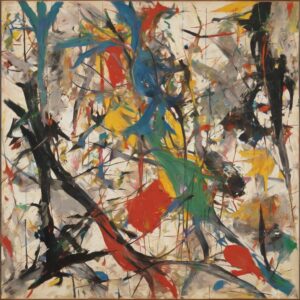Abstract Expressionism, also known as Action Painting or gestural abstractivism, was an influential art movement that developed in the United States in the 1940s and 1950s. This movement, which emerged in response to the social upheavals and traumas of World War II, was characterized by abstract paintings that emphasized emotion, spontaneity, and personal expression. Abstract Expressionist artists sought new forms of artistic expression by challenging traditional notions of form, color, and composition, and exploring a new level of subjective experience.
The use of generative artificial intelligence (AI) in the context of Abstract Expressionism opens up fascinating possibilities to explore the characteristic features and themes of this art movement and to develop new forms of creative design. Generative AI algorithms can learn to mimic the visual elements and techniques of abstract expressionism and generate innovative artworks that capture the essence and spirit of this movement.
A central feature of Abstract Expressionism is the emphasis on spontaneous and gestural expression. Artists such as Jackson Pollock and Willem de Kooning developed new techniques in which they hurled or brushed color and form onto the canvas with great intensity and dynamism. Generative AI algorithms can learn to mimic these gestural movements and generate artworks that capture the impulsive and emotional qualities of abstract expressionism.
Another important feature of Abstract Expressionism is the emphasis on color as the primary means of expression. Artists experimented with bright colors and strong contrasts to create emotional effects and express inner landscapes. Generative AI algorithms can learn to analyze these color compositions and generate artworks that capture the powerful and sensual quality of color in abstract expressionism.
In addition, Abstract Expressionism is characterized by a variety of styles and approaches, ranging from spontaneous abstraction to lyrical abstraction. Artists such as Mark Rothko and Joan Mitchell developed unique visual languages and expressions that explored the unconscious, the spiritual, and the mystical. Generative AI algorithms can learn to capture these diverse styles and approaches and generate artworks that reflect the breadth and diversity of abstract expressionism.
However, it is important to emphasize that the use of generative AI in the art field also raises ethical questions, especially in terms of originality, authorship, and cultural appropriation. Artists using generative AI should ensure that their work meets ethical standards and maintains integrity and authenticity in the art world.
When generating the art style of Abstract Expressionism using Artificial Intelligence (AI), there are several important aspects to consider in order to successfully capture the characteristic features and moods of this art movement:
- Spontaneity and gestures: A central aspect of Abstract Expressionism is the emphasis on spontaneous and gestural expression. Abstract Expressionist artists such as Jackson Pollock and Willem de Kooning used expressive gestures and movements to transfer their emotions to the canvas. Generative AI algorithms must learn to mimic these gestural movements and generate artworks that capture the impulsive and dynamic qualities of abstract expressionism.
- Color as a means of expression: Color played a central role in Abstract Expressionism, with artists using bright colors and strong contrasts to create emotional effects. Generative AI algorithms must learn to analyze color choice and arrangement and generate artworks that capture the powerful and sensual quality of color in abstract expressionism.
- Subjective Expression and Emotion: Abstract Expressionism emphasized the subjective expression and individual emotion of the artist. Works of art should not only depict external realities, but also reflect inner landscapes and emotional states. Generative AI algorithms must learn to capture complex emotional nuances and generate artworks that evoke a strong emotional resonance in the viewer.
- Experimental techniques and materials: Abstract Expressionist artists experimented with a variety of techniques and materials, including dripping or splashing paint, scratching or scraping surfaces, and layering different layers. Generative AI algorithms must be able to learn these experimental techniques and generate artworks that reflect the spontaneous and experimental nature of Abstract Expressionism.
- Freedom and abstraction: Abstract Expressionism was characterized by a renunciation of representational representation and a turn towards pure abstraction. Artists sought new forms of artistic expression by challenging traditional notions of form and composition. Generative AI algorithms must learn to recognize abstract shapes and structures and generate artworks that embody the freedom and experimentation of abstract expressionism.
By taking these important aspects into account, generative AI algorithms can create artworks that capture the essence and spirit of abstract expressionism and open up new possibilities for creative design. Nevertheless, it is important to emphasize that the generation of art by means of AI also raises ethical questions, especially in terms of originality, authorship, and cultural appropriation. Artists using generative AI should ensure that their work meets ethical standards and maintains integrity and authenticity in the art world.
Overall, the use of generative AI in the context of Abstract Expressionism offers an exciting opportunity to cross the boundaries between man and machine and explore new forms of artistic creativity. By combining human inspiration and machine intelligence, new works can be created that bring the timeless principles and cultural significance of Abstract Expressionism into a modern and technologically advanced era.



















